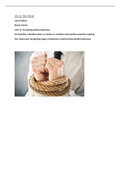Unit 12, Task 2 Resub
Laura Palmer
Stacey Tanner
Unit 12- Promoting positive behaviour
P3- Describe a situation where a reactive or restrictive intervention would be required
M2- Assess how recognising stages of behaviour could promote positive behaviour
, In this assignment I will be describing a situation where a reactive or restrictive intervention would
be required. I will also be assessing how recognising stages of behaviour could promote positive
behaviour.
P3- Describe a situation where a reactive or restrictive intervention would be required
There are 5 restrictive interventions. The key principles of restrictive interventions include that it
must not be used in order to cause pain to the individual, or to humiliate and embarrass the
individual. Restrictive practice can only be used if the risk of harm and danger is high. This means
that if someone is just doing something that you do not want them to do but they are not putting
themselves or others at any risk of harm, the practitioner cannot use a restrictive intervention. The
technique that is used must be relative to the potential harm. For example, if someone has an object
that they were going to use to harm either themselves or others and the object is removed,
restrictive interventions do not to be used if there is no longer a risk of harm to individuals. The
techniques used must be the least restrictive to meet the individual’s needs. The restrictions must
only be applied for as long as necessary and no longer. Once an individual has calmed, they should
move to a reactive intervention to help prevent negative behaviour from reoccurring. Any
interventions that are used must be documented in full explaining what intervention was used and
why.
Physical restraint involves physical contact being made to stop an individual from doing something
that they want to. "Any direct physical contact where the intention is to prevent, restrict, or subdue
movement of the body." (Restraint in mental health services, 2015) Physical restraint may be used to
prevent harm from occurring or stop harm from continuing, for example, during the London terror
attack, members of the public physical restrained a suspected terrorist who was stabbing people.
Physical restraint must not be with using excessive force. It must not prevent the individual from
breathing, they should not be covering the individual’s mouth or nose. They also should not be
applying pressure to an individual’s neck, ribs, or abdomen. The practitioner restraining the
individual should not put them in a face down position as this may restrict their airways.
Mechanical restraint is the use of a device, such as hand cuffs, to protect from harm. "For example,
staff could support an individual who self-harms by banging their head on the wall through using a
cushioned helmet."(Restraint in mental health services, 2015) Mechanical restraint is used to
prevent movement of the body in order to control behaviour. It can be used to protect the individual
themselves from harm or others around them.
Chemical restraint is another restrictive intervention. Chemical restraint involves using medication in
order to sedate someone. Health and social care practitoners can use this restrictive intervention
when there are aggressive or violent behaviours, but it can only be administered by a trained
healthcare professional and only if it's been prescribed.
Seclusion is where an individual is placed in isolation away from others. Health and social care
practitoners can only use this restrictive practice if the individual has been detained under the
Mental Health Act. This was misused in Winterbourne View Care Home as practitoners would
prevent service users from leaving their rooms if they wanted to “punish” individuals.
Long term segregation is where individuals are isolated from others over a longer period of time.
Health and social care practitoners can only use this restrictive practice if the individual is a serious
danger to themselves or others.





